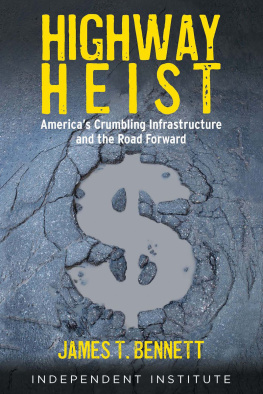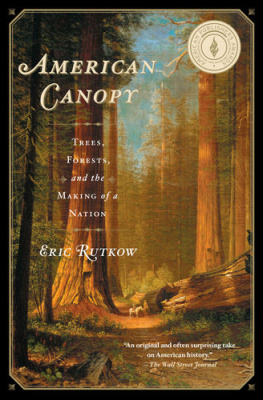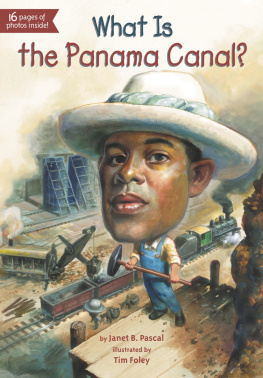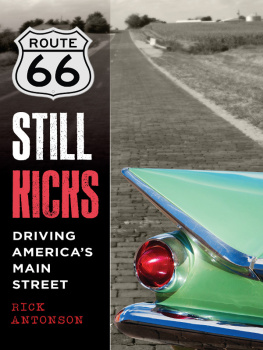Thank you for downloading this Simon & Schuster ebook.
Get a FREE ebook when you join our mailing list. Plus, get updates on new releases, deals, recommended reads, and more from Simon & Schuster. Click below to sign up and see terms and conditions.
CLICK HERE TO SIGN UP
Already a subscriber? Provide your email again so we can register this ebook and send you more of what you like to read. You will continue to receive exclusive offers in your inbox.
We hope you enjoyed reading this Simon & Schuster ebook.
Get a FREE ebook when you join our mailing list. Plus, get updates on new releases, deals, recommended reads, and more from Simon & Schuster. Click below to sign up and see terms and conditions.
CLICK HERE TO SIGN UP
Already a subscriber? Provide your email again so we can register this ebook and send you more of what you like to read. You will continue to receive exclusive offers in your inbox.
ALSO BY ERIC RUTKOW
American Canopy: Trees, Forests, and the Making of a Nation

Scribner
An Imprint of Simon & Schuster, Inc.
1230 Avenue of the Americas
New York, NY 10020
www.SimonandSchuster.com
Copyright 2019 by Eric Rutkow
All rights reserved, including the right to reproduce this book or portions thereof in any form whatsoever. For information, address Scribner Subsidiary Rights Department, 1230 Avenue of the Americas, New York, NY 10020.
First Scribner hardcover edition January 2019
SCRIBNER and design are registered trademarks of The Gale Group, Inc., used under license by Simon & Schuster, Inc., the publisher of this work.
For information about special discounts for bulk purchases, please contact Simon & Schuster Special Sales at 1-866-506-1949 or .
The Simon & Schuster Speakers Bureau can bring authors to your live event. For more information or to book an event, contact the Simon & Schuster Speakers Bureau at 1-866-248-3049 or visit our website at www.simonspeakers.com.
Interior design by Jill Putorti
Jacket design by Lauren Peters-Collaer
Jacket artwork: Pan-American March and Two-Step by Sheridan Libraries/Levy/Gado/Getty Images; World Map by Historic Map Works LLC/Getty Images
Library of Congress Cataloging-in-Publication Data
Names: Rutkow, Eric, author.
Title: The longest line on the map : the United States, the Pan-American Highway, and the quest to link the Americas / Eric Rutkow.
Description: New York : Scribner, [2019] | Includes bibliographical references.
Identifiers: LCCN 2018043679 | ISBN 9781501103902 (hardcover) | ISBN 9781501103919 (pbk.) | ISBN 9781501103926 (ebook)
Subjects: LCSH: Pan American Highway System. | RoadsAmericaHistory. | United StatesForeign relationsAmerica.
Classification: LCC HE358 .R88 2018 | DDC 388.1/22097dc23
LC record available at https://urldefense.proofpoint.com/v2/url?u=https-3A__lccn.loc.gov_2018043679&d=DwIFAg&c=jGUuvAdBXp_VqQ6t0yah2g&r=ATh3bu79KSZJC2mHobPsF7IIIi28o-UPyxJ5n0kknw29qy141ZQdEWou5Xio05RJ&m=uJIOt4JhGQ0-UqpO8XQrByMSZplj5H7TX_g4CsGzFFw&s=QVGgynWu_HxKdBbQMwlGB9Rl_ImWanUvu6jWq97Euk4&e=
ISBN 978-1-5011-0390-2
ISBN 978-1-5011-0392-6 (ebook)
For my sister

Two panels in the Universalis Cosmographia Secundum (c. 1507) showing the first European depiction of the Americas. Note the gap between the two continents, signifying an initial belief that North and South America were unconnected.
Introduction
The highway unfolded before Sal Paradise. It was the spring of 1949, and Paradise, the narrator of Jack Kerouacs On the Road , had decided to head in a new direction. For the past several years, he had vagabonded across the United States in an endless chase of freedom, but now the road was leading him and his friend Dean Moriarty beyond the nations borders for the first time. I couldnt imagine this trip, said Paradise. It was the most fabulous of all. It was no longer east-west, but magic south . We saw a vision of the entire Western Hemisphere rockribbing clear down to Tierra del Fuego and us flying down the curve of the world into other tropics and other worlds. The last word went to Moriarty: Man, this will finally take us to IT!
Soon they entered Mexico on the Pan-American Highway.
* * *
The Pan-American Highway is the longest road in the world, running the length of the Western Hemisphere from Prudhoe Bay in Alaska to Tierra del Fuego in South America. It represents a dream of friendship, commerce, mobility, of the Americas united. Our collective imaginations have been forged along its path: Ernesto Che Guevara, the iconic Argentine revolutionary, traveled it northward in The Motorcycle Diaries ; Kerouac, the voice of the beat generation, followed it southward in On the Road . Many adventurers have journeyed the highways distance, but the road itself still remains shrouded in mystery. Why was it built? And why does it remain unfinished, with a sixty-mile-long break, the famed Darien Gap, between Panama and Colombia?
* * *
I first encountered the Pan-American Highway a decade ago as a tourist traveling through Latin America. Like Paradise, I spent little time thinking about how the road came to be. It seemed as though it had always formed part of the landscape, carving a path to connect the hemispheres capitals, skirting volcanoes and coastal deserts and teeming jungles along the way. Life in the New World almost appeared to have arisen along the route of the ever-present highway. The road became easy to take for granted, an indelible fixture of the region.
The Pan-American Highway only piqued my historical curiosity several years later, after I read in an obscure volume that its construction in Central America and Panama had once been the largest foreign development project attempted by the United States. This assertion surprised me, as I had never before heard that the United States had played any role in the Pan-American Highway, let alone such a significant one. Why, I wondered, did the United States seek to build a foreign highway through half a dozen sovereign nations?
Soon I began searching through histories of USLatin American relations for more information on the highway. But my early investigations proved unsatisfying. The road rarely received more than a passing mention in any of those works. And the more I searched, the more elusive the road seemed to become. While hundreds of histories have been written on the hemispheres other great infrastructure project, the Panama Canal, none has ever been published on the Pan-American Highway.
* * *
The terms North America and South America are fictions created by geographers and mapmakers. The United States may seem separated by an ocean from South America, but in truth they both form part of the same American supercontinent. The American landmass is shaped like an hourglass, with Central America as the connecting link. Overland travel is theoretically possible along the entirety of the Western Hemisphere.
The historical relationship between the United States and Central and South America is rarely seen as one of overland neighbors. But this is a mistake. The shared dream of overland connectivityoriginally as a Pan-American Railway and later as a Pan-American Highwayexerted a profound influence on hemispheric development and relations over the course of a century.
The two infrastructure projects were the material embodiment of Pan-Americanism, an ideology birthed in the early 1800s and given modern form late that same century, insisting that the Americas shared a common destiny and mutual interests. For Pan-Americanists throughout the New World, no project better reflected their aspirationsand frustrationsthan this monumental quest to link the Americas.











